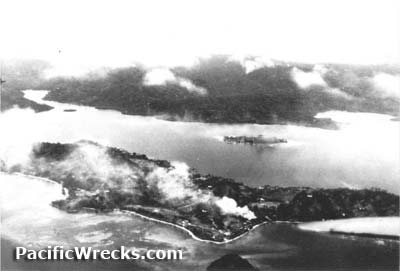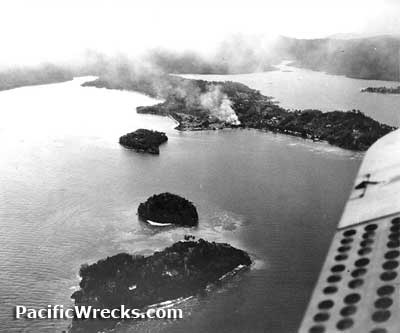American missions against Tulagi and Guvutu
May 4, 1942–August 7, 1942
 May 4, 1942
May 4, 1942
(USN) Carrier aircraft from USS Yorktown CV-5 arrived
over Tulagi and find only small vessels and landing
craft. They attacked and sink Kikuzuki, Tama Maru and WA-1, WA-2.
July 3, 1942
(5th AF) One A-24 bombs Tulagi [sic, this is likely a location in New Guinea].
July 23, 1942
(SOPAC) 11th Bombardment Group
B-17s on New Caledonia begin photo reconnaissance of the Guadalcanal-Tulagi-Gavutu
area.
July 30, 1942
(SOPAC) 11th Bombardment Group
B-17s on New Caledonia begin photo reconnaissance of the Guadalcanal-Tulagi-Gavutu
area.
 August 7, 1942
August 7, 1942
((USN) Dive bombers strike Gavutu and seaplane anchorage, buring seven large seaplanes (H6K Mavis). US Navy ships bombard the island, damaging the seaplane ramp. A pre invation bombardment hits targets on Gavutu, damaging the seaplane ramp and Tanambogo.
(USMC) At 12:00, US Marines of the 1st Parachute Battalion landed at Gavutu Air support for the
U.S Marines' first amphibious landing of World War II was provided by three
carriers
of Air Support Force (Rear Admiral L. Noyes), and by Navy, Marine, and Army
units of Aircraft, South Pacific (Rear Admiral J. S. McCain) operating from
bases on New Caledonia and New Hebrides.
Japanese missions Against Tulagi and Guvutu
August 7, 1942–June 16, 1943
August 7, 1942
Japanese G4M1 Betty bombers escorted by A6M2 Zeros attack shipping off Tulagi.
April 1, 1943
42 fighters (P-38's and Navy and Marine aircraft) are sent over the Russell
Islands to intercept Japanese enroute to Tulagi / Guadalcanal, and the incomplete airstrips in the Russells. A large IJN strike
force of Aichi D3A1 Type 99 (Val) carrier based dive-bombers, with Mitsubishi
A6M2 Type 0 carrier fighter, Model 21s (Zeke) from the IJN Carrier Division
Two (CARDIV 2), commanded by the IJN Rear Admiral Kakuta Kakuji, which included
the carriers ZUIKAKU, SHOKAKU, and the ZUIHO. The IJN CARDIV 1 was composed
of the carriers RYUJO, JUNYO, and HIYO. Aircraft from all of these carriers
had been shore based since February to replace the relocation of the Fourth
Kokutai transfer of its aerial assets of approximately 200 aircraft to Wewak.
The air battle lasts for nearly 3 hours. Six US fighters are lost, against
claims of 20 Japanese airplanes destroyed.
April 7, 1943
a large force of Japanese dive bombers and fighters is reported by coast watchers
to be moving down the "Slot." In its path are a convoy off the E coast of Guadalcanal,
shipping at Koli Point, and a Task Force at Tulagi. Every operable fighter
(76) on Guadalcanal is sent up, and the bombers are moved to the SW tip of
the island for safety. The air battle takes place off the Russells, near Tulagi,
and over the convoy.
May 13, 1943
During the day, 34 P-38's, P-39's, and P-40's, along with 62 Navy and
Marine fighters and Royal New Zealand Air Force (RNZAF) P-40's, intercept 20+
airplanes over the Russell Island-Tulagi area. Allied pilots claim 16 aircraft
shot down (1 by USAAF fighters).
June 16, 1943
About 120 Japanese aircraft
converging on Allied vessels off Tulagi and Guadalcanal Islands in the
Solomon Islands are met by more than 100 Allied fighters (USAAF, Royal New
Zealand Air Force, US Navy and US Marine Corps). The skies over Savo and Tulagi, and Cape Esperance and Koli Point on Guadalcanal Island are
filled with dogfights and flak from ship and ground guns. The battle results
in the largest single-day Allied aerial victory of the Solomon Islands
campaign; 79 airplanes are claimed shot down by Allied fighters, and AA
claims 17 more; 6 Allied fighters are lost. The Japanese succeed in damaging
3 ships (2 of which have to be beached) and cause considerable destruction
on Guadalcanal.